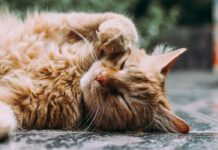Here is a look at some of the most common ferret diseases and conditions.
Ferret Adrenal Disease
One of the most common conditions that affect ferrets is adrenal disease. The growth or enlargement of the adrenal gland typically requires surgery.
External signs of this condition are loss of hair, usually starting at the tail and working forward. Sometimes the back of the neck loses hair. In some cases, the vulva of females becomes enlarged too.
If you catch and treat this disease early, prospects for recovery are good. If left untreated, it is fatal.
ADV
Aleutian Disease Virus (ADV) is a parvovirus that can infect ferrets and their cousin species, such as minks. It produces excessive and rapid weight loss. There’s no cure and it can be fatal, though in many cases it produces symptoms that are treatable.
ADV can be transmitted through urine and feces, so it’s possible for one ferret to be a carrier (but not infected) to infect others. Tests can show whether an animal has the virus and it’s helpful to have one done before introducing a new ferret to your other ferrets. CEP or CIEP (Counter Immune ElectroPhoresis) is the most common test.
ECE
Epizootic Catarrhal Enteritis, also known as Green Slime Disease, is an inflammation of the mucous membranes. It leads to green slimy, foul-smelling feces during diarrhea (hence the name). Yes, all feces smell, but ferrets can get greenish diarrhea for a number of reasons. These are distinctive. The causes are not entirely understood.
This condition may last only a week or two and go away untreated. But in about 20% of cases it can become more serious, leading to wasting away. In any case, owners should seek treatment as early as possible. Only known for a little over 10 years, it’s still being heavily researched. Treatments vary, such as the use of slippery elm bark powder, but should be applied by a vet.
Ferret Ear Problems
It’s very important to keep your ferret’s ears clean – and it’s pretty simple too. Wax can build up, or they can get ear mites and other conditions.
You can use a weak solution of ear cleaner to help loosen the wax then, like a dog, they will shake their heads vigorously to expel the wax.
Treating ear mites requires only a little ear cleaner, then Tresaderm. The procedure should be repeated every day for at least a week. Careful examination with a flashlight and magnifying glass can help reveal any substance that might still be in the ear. A ferret’s ear canal is L-shaped, so piercing the ear drum isn’t a common problem. But they are delicate, so take care.
Cancers
Older ferrets, around 4 years or more (like other aging mammals) are prone to develop tumors and other cancers. Some of these are treatable by surgery, others eventually take the life of the ferret. But ferrets are no more prone to cancer at a young age than a dog, cat or humans.
Still, since they are very curious and exploratory, it’s helpful to ensure they don’t come into contact with common household items that can encourage cancers. Benzene and other organic solvents are known to increase the risk. Be sure to ferret-proof your house.




















 A Scarlet Macaw requires as large a cage as possible – at least 3 or 4 feet wide and deep by 5 or 6 feet tall. The cage will ideally have a perch or play area attached to the top or side of the cage for exercise and stimulation. Provide them with plenty of toys to play with and objects to chew on such as wood blocks and mineral blocks.
A Scarlet Macaw requires as large a cage as possible – at least 3 or 4 feet wide and deep by 5 or 6 feet tall. The cage will ideally have a perch or play area attached to the top or side of the cage for exercise and stimulation. Provide them with plenty of toys to play with and objects to chew on such as wood blocks and mineral blocks.











